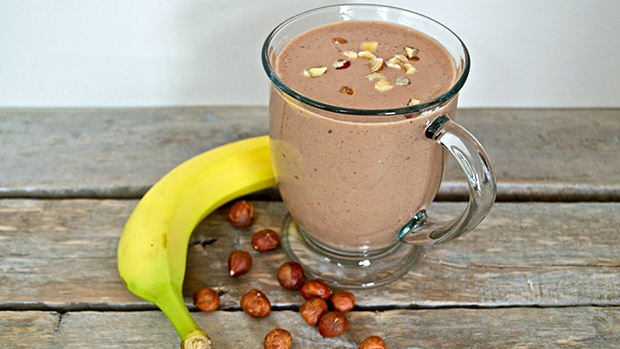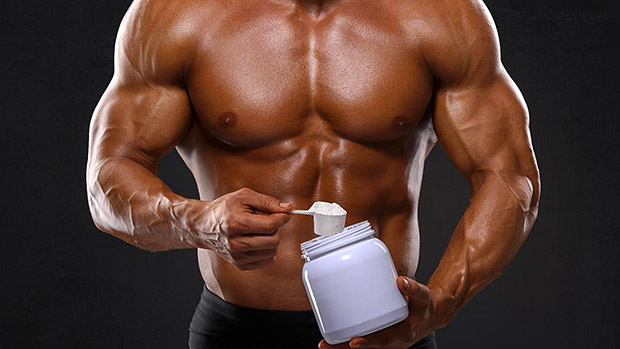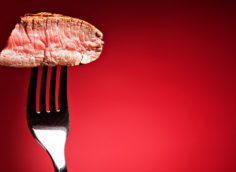The Blueprint for Gains
When most hardgainers ask for advice, they're told simply to eat more. Unfortunately, eating more doesn't address the problems of raging metabolism, high stress hormones, poor digestion, and pathetic appetite that plague most skinny guys. But with the right guidelines and some hard work, you can say goodbye to your former skinny self – forever!
Here's the blueprint I used to pack 50 pounds of lean muscle onto my scrawny frame. Not only did it work for me, but it also worked for my clients and my athletes. It's time for you to put the "gainer" back in hardgainer.
When it comes to building muscle, the most important thing is training. Even in situations that aren't ideal, the body can build muscle to survive the threat imposed by training. Research has shown you absolutely can build muscle in a calorie deficit (if protein intake is high) (1). And anecdotal evidence from prisons shows that guys get jacked all the time, despite awful nutrition.
This is not in any way suggesting that eating isn't important. No skinny guy will gain a respectable amount of muscle without proper nutrition. However, you need to have your priorities straight. Muscle building starts with hard training, and perhaps surprisingly, hard training will improve your eating.
Consider that one of the biggest obstacles a hardgainer has is a pathetic appetite. Hard training is one of the fastest, easiest ways to increase your appetite. It makes your body demand more food and this makes eating large amounts of food way easier.
Oddly enough, your appetite can actually help you find your training sweet spot. Too little training will do nothing to increase your appetite. Too much training will actually decrease your appetite. The right amount of hypertrophy training will leave you ravenous!
Research on lean, healthy subjects shows an increase in BMR (basal metabolic rate) for about the first two weeks with overfeeding (2). That means when you try to eat big, your body's first response is to increase its metabolic rate.
This is precisely why just eating more doesn't always work for hardgainers. They take the advice, go out and start eating more for a couple weeks, and then find the scale won't budge. Now the hardgainer thinks he's a non-gainer. He gives up on nutrition and thinks some magical new biceps curl variation is the real secret to getting jacked.
Look, this spike in your already naturally fast metabolism is part of the game. Don't worry, it won't keep increasing forever, but you need to be patient. You need time for your body to get used to consuming larger volumes of food. In fact, you may not even be able to eat and properly digest the amount of quality food you need to build muscle... yet.
You need time to get used to eating more and following the other new lifestyle habits and strategies in this blueprint. Stay the course, let your body adapt, and the scale will start moving up. If you're not in this for the long haul, you need a different hobby.

Hardgainers already have too many stress hormones pumping through bodies. As a result, losing muscle is fast and easy while gaining it is slow and difficult. Many hardgainers add even more stress to their bodies by abusing pre-workout stimulants.
Remember, the only stimulant you "need" for a great training session is a strong mind, and instead of getting all hopped up on stimulants before training, fuel your body with peri-workout nutrition. It'll give you extra protein, carbs, and calories without taking up room in your stomach or taking up time to prepare more food. Also, the insulin from the carbs has a powerful anti-catabolic effect, which shuffles the hormonal deck in your favor.
Think back to your childhood. Remember how you were so full that you couldn't eat another bite of dinner? But then, when presented with surprise dessert, you regained your appetite. As a kid, I thought I had a separate dessert stomach. I now know it was just a case of palette fatigue.
When you eat a lot of one type of food, your palette simply gets bored of that flavor and texture and you stop wanting to eat. When most hardgainers try to eat, they just eat more of what they're already eating. They try stuffing down more chicken, rice, and broccoli, and it doesn't work. Their palettes get so tired of the same stuff that they stop eating long before they reach the level of food necessary to build muscle.
Instead of eating more, add more items to your meals. Increase the flavors and textures at your meal and watch the scale finally start to climb. For example, let's say your typical breakfast consists of the following:
- 3 eggs
- 2 pieces of toast or oatmeal
- 1 apple
Gradually add items until you get to this breakfast:
- 1 scoop Metabolic Drive® Protein in water
- 4 eggs with spinach & tomato
- 1 cup of yams or hashbrown potatoes
- 2 pieces of toast or oatmeal
- 1 apple
- 1 banana
This is a lot more enjoyable and easier to eat than just doubling the size of your original breakfast.
Think of the times when you ate the most food. I bet those meals were delicious. When food tastes good, it's easy to eat more, so if you're truly serious about transforming your body, you need to cook your own great-tasting food (or pay someone to cook exactly what you want).
There are endless free recipes available online. Alternately, you probably have a friend or family member who can give you some lessons. Invest the time to learn to cook muscle-building meals you actually enjoy. This makes eating a lot easier.
Along the challenges of a poor appetite and a raging metabolism, hardgainers sometimes have poor digestion. Many healthy foods such as whole grains, beans, and raw veggies are harder to digest and difficult to eat in high quantities.
It doesn't mean you have to avoid them completely, though. By choosing more foods that are easier to digest, it'll be much easier to get the nutrients and calories you need with a lot less gut discomfort.
Here are some examples of more easily digested foods that should form the core of your accelerated eating plan:
- Eggs
- Ground meats
- Protein powder
- Steamed or stir fry veggies
- Potatoes
- White rice
- Blended fruits and greens
- Fish
- Olive and coconut oil
Another helpful trick for making things easier on your digestion is to drink 1-2 power shakes per day. Here's a simple recipe:
- 1.5 to 2 cups of water
- 2 bananas
- 1 cup frozen berries
- 2 tbsp of fat (e.g., nuts, nut butters, coconut oil, ground flax)
- 1.5 to 2 scoops of protein powder

Healthy foods give you more than just calories. They provide you with nutrients to ensure that your body is energized and can recover at optimal rates. This doesn't mean you need to turn into some clean-eating Nazi. The key word is "emphasize."
While many hardgainers are so afraid of losing their abs that they never even hit maintenance calories, you don't want to go to the other extreme and "dirty bulk."
A few years back, two of my interns (who were also, paradoxically, taking a sport nutrition course at the time) tried dirty bulking. They'd hit the gym, and then hit the fast food joints to stuff down piles of junk. While they both got stronger, they also got fat, developed bodies covered in acne, and suffered from inflammation and achy joints. Once they cleaned up their eating, they became leaner, stronger, healthier, more muscular, and had happier joints.
Remember that you're not a world-class strongman like Brain Shaw who needs 12,000 calories a day. This would be impossible to get with just healthy foods like chicken, rice and broccoli. However, getting 4,000 calories through healthy foods and shakes is quite doable.
As you evolve to need more than 4,000 calories, you can then add more healthy oils, nuts, dried fruits, starches (white rice and potatoes), and even a few treats. Sure, it's harder and not as much fun, but you'll love the results.
You schedule your training, but do you schedule your nutrition? By scheduling in shopping and meal prep, you always have the food you need and you'll find that it's easier to stick with the plan and pack on muscle. Here's how I lay out my weekly plan:
- Monday: Training
- Tuesday: Grocery shopping & training
- Wednesday: Meal prep
- Thursday: Training
- Friday: Grocery shopping & training
- Saturday: Meal prep
- Sunday: Rest and relax
Trying to follow some generic meal plan seems like a good idea... for about a day. A better approach is to personalize your nutrition. Learning to cook food you enjoy is a great step. Here are two more things you can do:
- Pay attention to how you feel 1-2 hours after eating. This is the easiest and cheapest way to personalize your diet. Once you're emphasizing healthy foods, you'll still find there are certain foods or combinations of foods that leave you gassy, bloated, irritated, or sleepy. Limit or avoid these foods.
- Adjust amounts and ratios. Make adjustments based on what your training log, scale, and tape measure is telling you. I start people off by making them nail down their protein. A simple gram per pound still works well for most guys.
Once you have your protein down, you can add more carbs or fats until you start growing. While a hardgainer shouldn't try to go to extremes with carbs or fats (don't drastically curtail either one), you can play with your carb-to-fat ratios to find what works best for you.
When trying to build muscle, you often find that despite your brutal training sessions, the hardest part is the nutrition. At times, you'll feel like your jaw and digestive system are overtrained.
A great way to deal with this is to take a day off from intense eating. No, this doesn't mean you have to fast or be in a huge calorie deficit. It just means you take a day to relax, have a few treats, stop force-feeding yourself, and just eat as much as you feel like eating.
You can also drop your meal frequency on that day from 4-5 meals to 3 meals. The mental and physical break will be the thing you need to set yourself up for another productive week of training and eating your way to bigger muscles.
- Longland TM et al. Higher compared with lower dietary protein during an energy deficit combined with intense exercise promotes greater lean mass gain and fat mass loss: A randomized trial. Am J Clin Nutr. 2016 Mar;103(3):738-46. PubMed.
- Harris AM et al. Weekly Changes in Basal Metabolic Rate with Eight Weeks of Overfeeding. Obesity (Silver Spring). 2006 Apr;14(4):690-5. PubMed.





